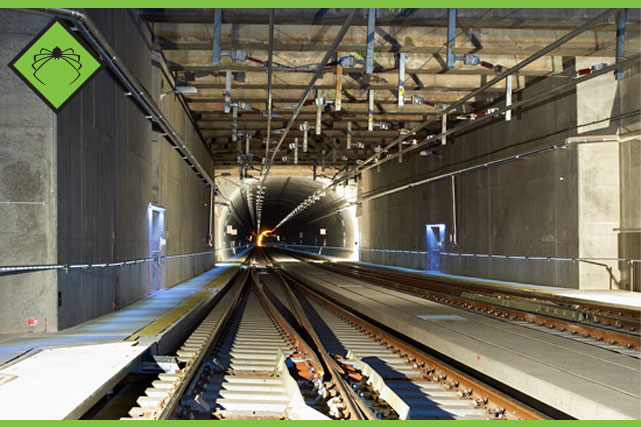 The Challenge
The Challenge
The challenge for this project was to implement a VHF and digital wireless system in the
Purkersdorf switch hall with Kapsch CarrierCom for the national Austrian railway operator
ÖBB (Österreichische Bundesbahnen) - a deal worth €1.3M in total. The system needed
to include a completely redundant public safety system and a public network for national
mobile network operators, including provision for DVB-H.
Digital wireless train communications aimed at industry logistics are evolving rapidly in
Europe with the EU standardisation of cross-border communications and the panEuropean connection of the GSM-R networks. ÖBB needed to install a digital system in Purkersdorfer switch hall that would meet these standards and offer the latest in public
safety systems as well as streamlining rail logistics, and offer customers the latest in
mobile digital services.
Currently under construction and due to open in 2012, the Lainzer Tunnel will be 12km
long and link the Western railway line and the Southern and Donaulände railway lines,
while the Purkersdorfer switch hall will connect the Lainzer Tunnel and the new ViennaSt. Pölten line with the Western line
The digital wireless system required by ÖBB needed to meet all the communication
requirements of the railway network, the emergency services (digital and analogue) and
national mobile network operators. This required a system to be designed that would
serve the dual purpose of providing wireless coverage for both public safety and
commercial usage.
To meet security standards, the radio system needed to provide coverage for GSM-R
(global system for mobile communications - railway) and TETRA (terrestrial trunked
radio), a two-way radio standard used by the emergency services. The commercial layer
also needed to provide coverage across the GSM spectrum at different frequencies for
three operators, including 3G and DVB-H to allow mobile device users to access voice and
data services.
 The Solution
The Solution
A dual-layer multiband commercial and public safety system supplied by PBE Axell
and installed by Kapsch Carrier was the solution. This included PBE Axell's new triband optical master unit (OMU) and its management software to integrate the systems.
PBE Axell, together with Kapsch CarrierCom, designed the entire system to run
on its "complex combiners", and through its software manager - Active Element Manager
(AEM) - to create a balanced system with one technological interface, which Kapsch
CarrierCom installed. To integrate the TETRA, GSM and analogue standards, PBE Axell provided its OMU to act as a central hub and bring the different radio
frequencies back to the unit, which was installed with an automatic gain setting, creating
a simple installation process for Kapsch CarrierCom who could then leave it running,
confident that any changes required to optimise the network would be done
automatically. The system was also designed with radiating cable to enable energy
displacement.
The public safety layer included an AWS (automatic warning system), a siren warning
system to warn maintenance workers in the tunnel of any incoming trains. GSM-R was
included for ÖBB, and an analogue train radio system to ensure legacy systems remained
operational, as well as integrating the new EU-defined standard TETRA BOS, and last but
not least analogue services for the Vienna fire brigade.
To deliver the commercial coverage for public use, PBE Axell delivered cabinets or
industrial mount units, which contained all the necessary equipment including combiners
and repeaters. The hardware was tailored to meet the requirements of each individual
installation, delivering the shortest possible cable length to significantly reduce signal
loss. PBE Axell also included two separate alarm systems in every cabinet to
control the parameters in each, such as signal measurement and system calculation, and
ensure ÖBB had a full view of all network events.
The standards covered included GSM-900 (6 carrier), GSM-1800 (6 carrier), UMTS (8
carrier) and a full preparation of the whole system to extend DVB-H.
 The Benefit
The Benefit
PBE Axell and Kapsch CarrierCom are the sole suppliers of all the equipment,
from amplifiers to racks and combiners, which meant that ÖBB finished with a single
point of contact - Kapsch Carrier Com - rather than the multiple vendors usually needed
for a multiband network such as the Lainzer Tunnel. The system is a cohesive one where
all the different elements or technologies run uniquely over one single system, and was
designed to use the minimum amount of space and be neat in appearance.
The integration of all alarms nation-wide in the ÖBB railway network gives the operations
managers complete visibility into network activity, while the automatic signal level control
of each signal leaves them free to focus resources where needed. Additionally, the
completely redundant system means that if anything fails, the system will overrun, so
there is no risk of signal not being carried.
The system can also be easily extended for different channels and services, something
which is traditionally very awkward to achieve in a multiband, multivendor environment.


